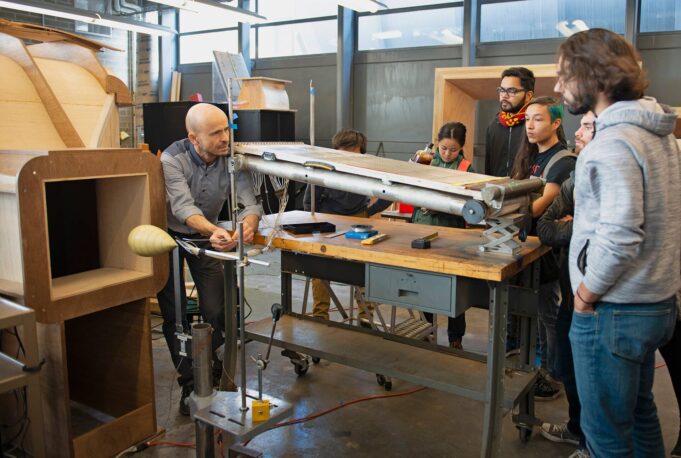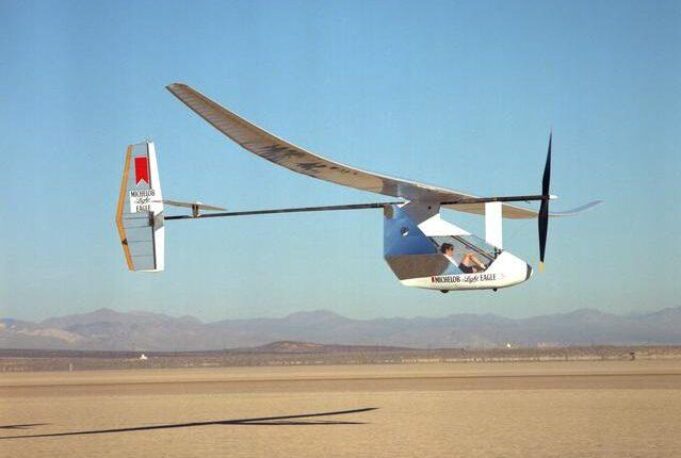The Airplane Whisperer
This essay originally appeared in Angles 2019.
Imagine trying to bake a perfect cake without a recipe in one try. Where would you start? Perhaps you would think of the qualities of cakes you have eaten—taste, texture, frosting, shape—think about what you know about baking, and try to bring the two together. Now imagine what an aeronautical engineer has to bring together to design a “perfect” airplane—one that would meet all his/her design requirements when it takes flight for the first time. Computer simulations attempt to solve this problem, enabling engineers to estimate how an airplane would fly if it were actually built. Before computer simulations, the only way to predict how an airplane design performs was to build a small model version and test it in a wind tunnel, a very expensive and time-consuming process. For that reason, engineers would often design new airplanes by looking at existing airplanes and copying what worked, just as you would do when trying to bake a cake. This method hindered innovation. Computer simulations can theoretically allow an engineer to design and evaluate airplanes in real-time. However, to design fuel-efficient, safe, and reliable airplanes, thousands of computer simulations are necessary, a task that was almost impossible until just decades ago.
The solution to making airplane design easier came from Mark Drela, a professor in MIT’s Aeronautics and Astronautics department. Professor Drela has been designing model airplanes his whole life. He started folding paper airplanes at age 3, moved on to balsa gliders at age 5, built powered models in high school, worked on human-powered aircraft in college, and is now a world champion model glider designer. Professor Drela’s deep interest in making airplanes more efficient has become the basis of both his career and his hobbies.
As much as Professor Drela loves airplanes, he’s “not crazy about commercial flying. It’s like being in a car with a crowd. Some people are in awe,” he says, “but ehh.” One of Professor Drela’s goals, therefore, is to make commercial airplane flights more comfortable for passengers by streamlining the boarding process and by making airplanes faster and less expensive. His solution was to help develop the field of computer-based airplane simulations to allow engineers to preview how the airplane will fly before it is built. Simulations work by taking in ingredients specified by the engineer and outputting an estimate of the airplane’s characteristics. Simulations can save a lot of time because they catch mistakes before the airplane is built.
Commercial airplanes have about 6 million parts. Only parts on the outside surface, however, affect their aerodynamic properties, which impact fuel efficiency, speed, and safety. Professor Drela’s research focuses on simplifying the shape of an airplane into an outline of simple geometric shapes that can be easily processed by a computer. Parts such as windows, doors, and lights have an insignificant effect on the aerodynamics of the airplane, so they can be ignored. According to Drela, “You need to distill the definition of the wing to a set of design parameters that you can wrap your head around. You need to design the overall form before you start worrying about extraneous details.” This is comparable to simplifying an entire novel into twenty words while still retaining complexities such as the nuances of the story and character interactions.
In the 1980s, Professor Drela developed the first user-friendly computer program that can simulate airplanes in flight. The program, called XFOIL, can be used on almost any computer and is operated by inputting simple parameters such as the approximate size, engine specs, and how fast the airplane should fly. Using Drela’s aerodynamic simulation code, XFOIL computes data about how the airplane would fly if it were built in real life. If there are problems with certain flight characteristics, such as maneuverability, stability, or engine power, the program can automatically try different input combinations until the best possible airplane design is created.
Even though Professor Drela is an expert aerodynamicist, he makes his programs easy enough for any engineer to use. Drela says, “I worry about user interfaces. If you have a method that you just can’t use, it isn’t very helpful.” XFOIL is still used today by aerospace engineers and model airplane enthusiasts because of its intuitive layout; the program laid the foundation for software used to design many commercial airplanes in service today.
In an attempt to once again revolutionize the aviation industry, Professor Drela is currently developing more advanced computer programs that can simulate passenger airplanes in more detail than in XFOIL. One of his new programs, called TASOPT (short for Transportation Aircraft System Optimization), simplifies a commercial airplane design to about 100 design parameters. He used this program while designing the D8, a fuel-efficient passenger airplane with a wider body than a traditional airplane that could use up to 70% less fuel than today’s equivalent. The wider body would also give passengers more room in the airplane. In addition, loading and unloading could be accomplished in about half the time, potentially saving around 30 minutes per flight.
Professor Drela’s research for the commercial airline industry also benefits hobbyists. His model airplane designs are revered by many model airplane enthusiasts for their efficiency and performance. Though Professor Drela enjoys his airplane simulations research, his real passion is building his own airplanes, both models and full size. When explaining his research, Drela speaks in a monotone, but when the subject shifts to his airplane projects, it seems he could talk for hours about a single model airplane. He often pointed out pictures and models displayed in his office to aid in his explanation. The Daedalus, one of Drela’s notable projects, holds the distance record for a human-powered airplane. He remarked that “the cool thing about my job is that it’s also my hobby. Most people have a side job and a hobby and can’t wait to get out. If you really like your work, it makes getting up in the morning a lot easier.”
Even after more than half a century of dedication to airplanes, Professor Drela is still mesmerized by his small wooden model airplanes. When he tosses one of these airplanes, it is apparent that he carefully analyzes the flight path, thinking of what he needs to modify to make it fly even better. Drela seems to think the same way about improving commercial airplane design. If there is a way to make an airplane more efficient, Mark Drela will make the tools he needs and dedicate his life to finding them.



